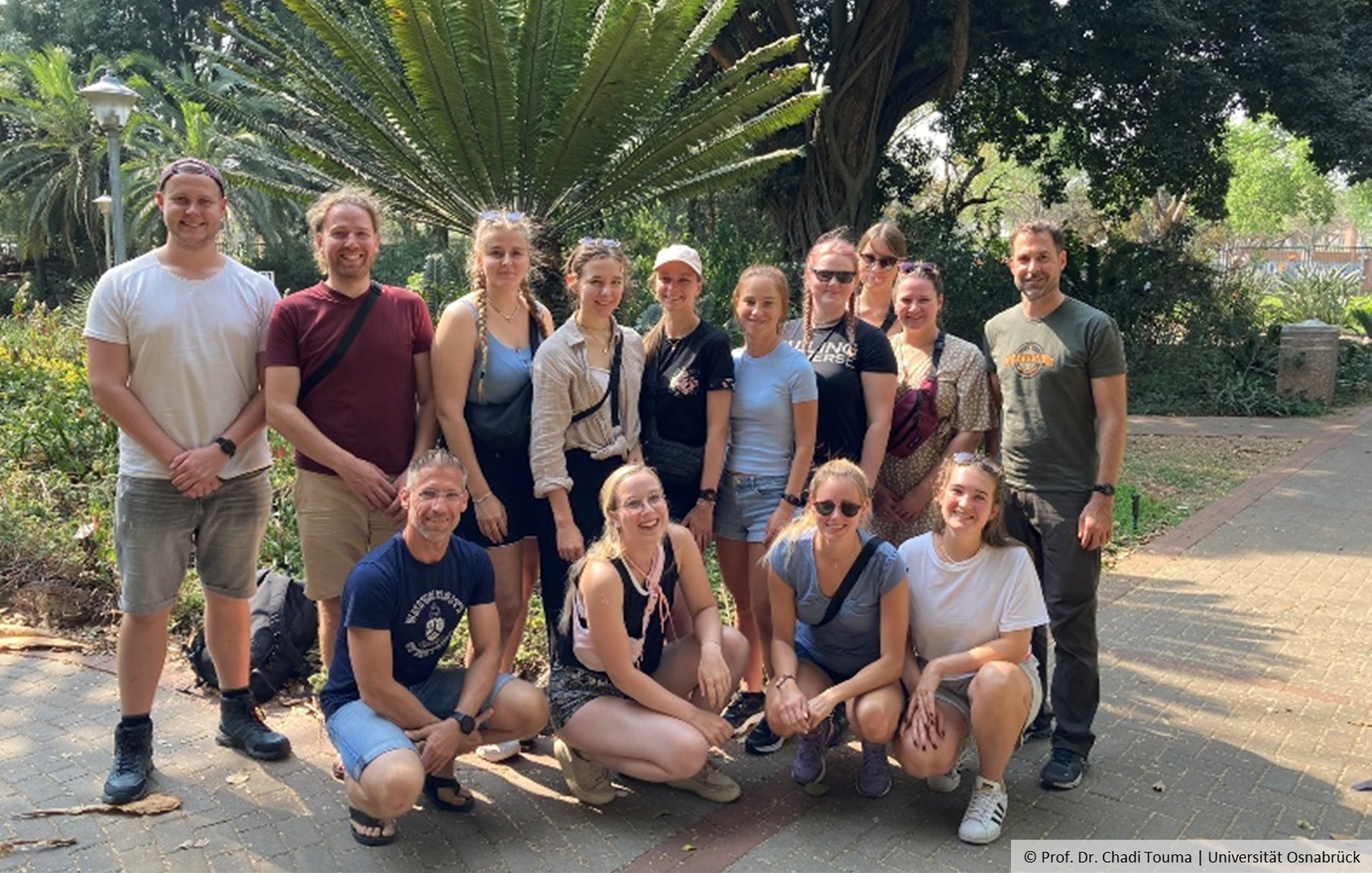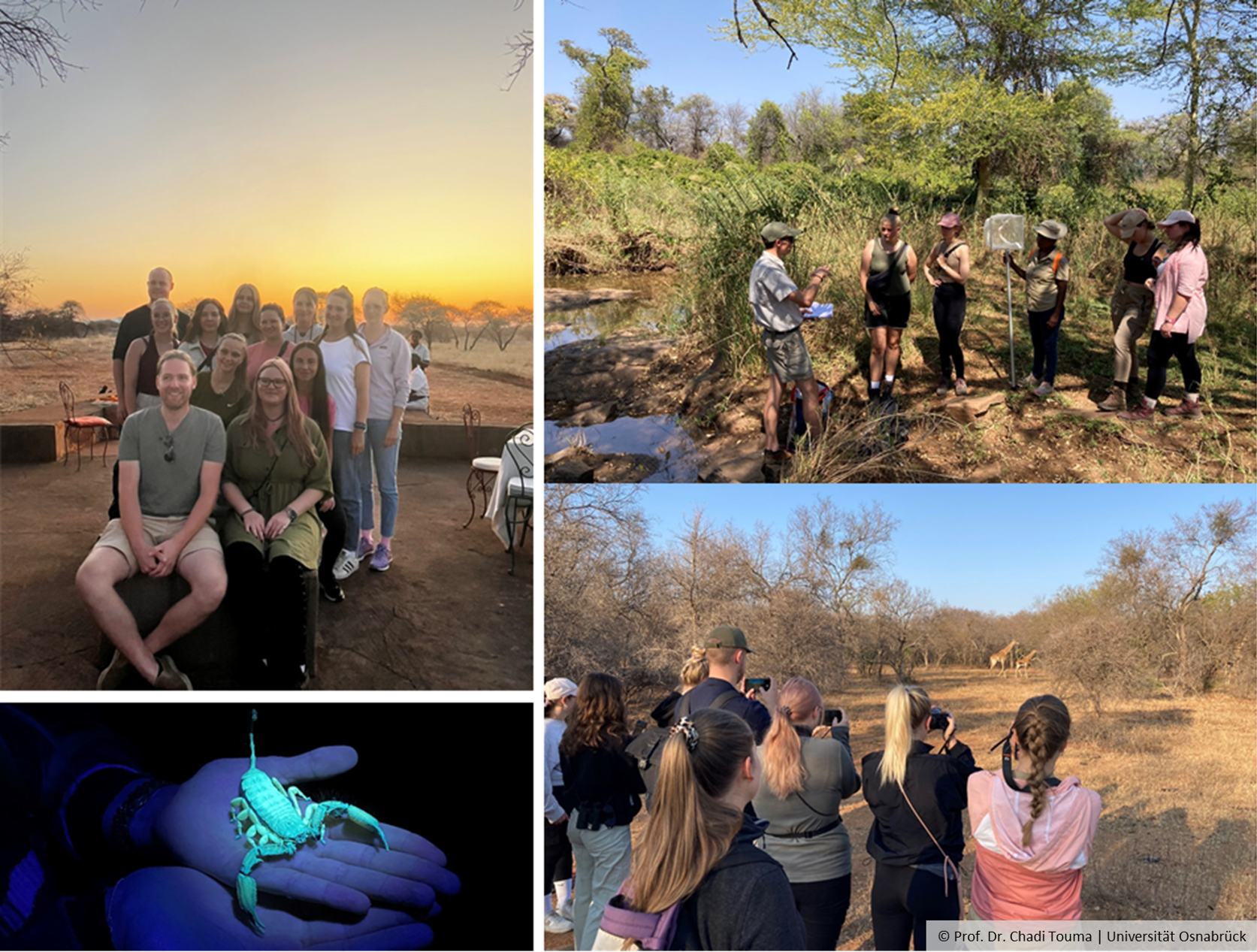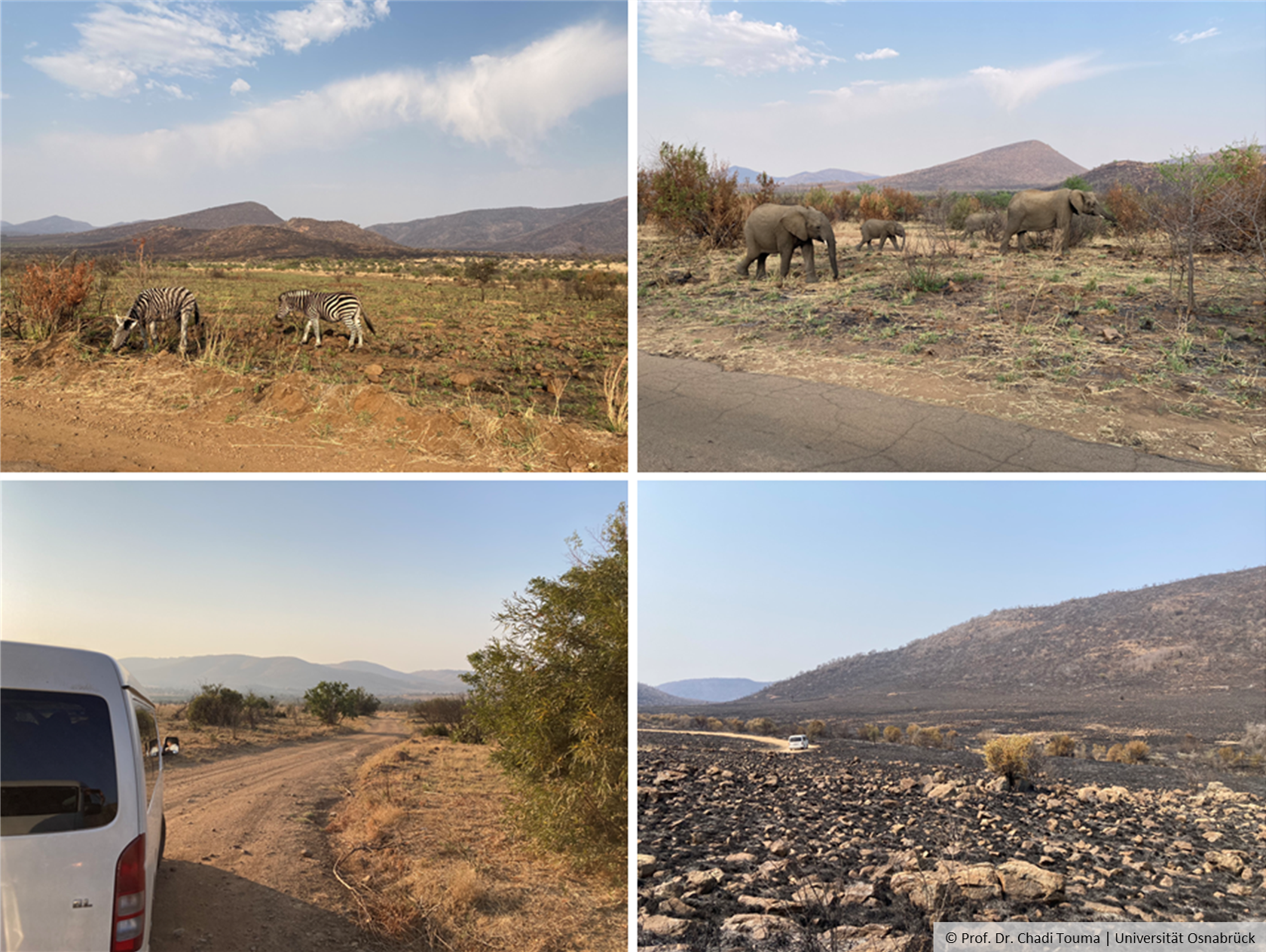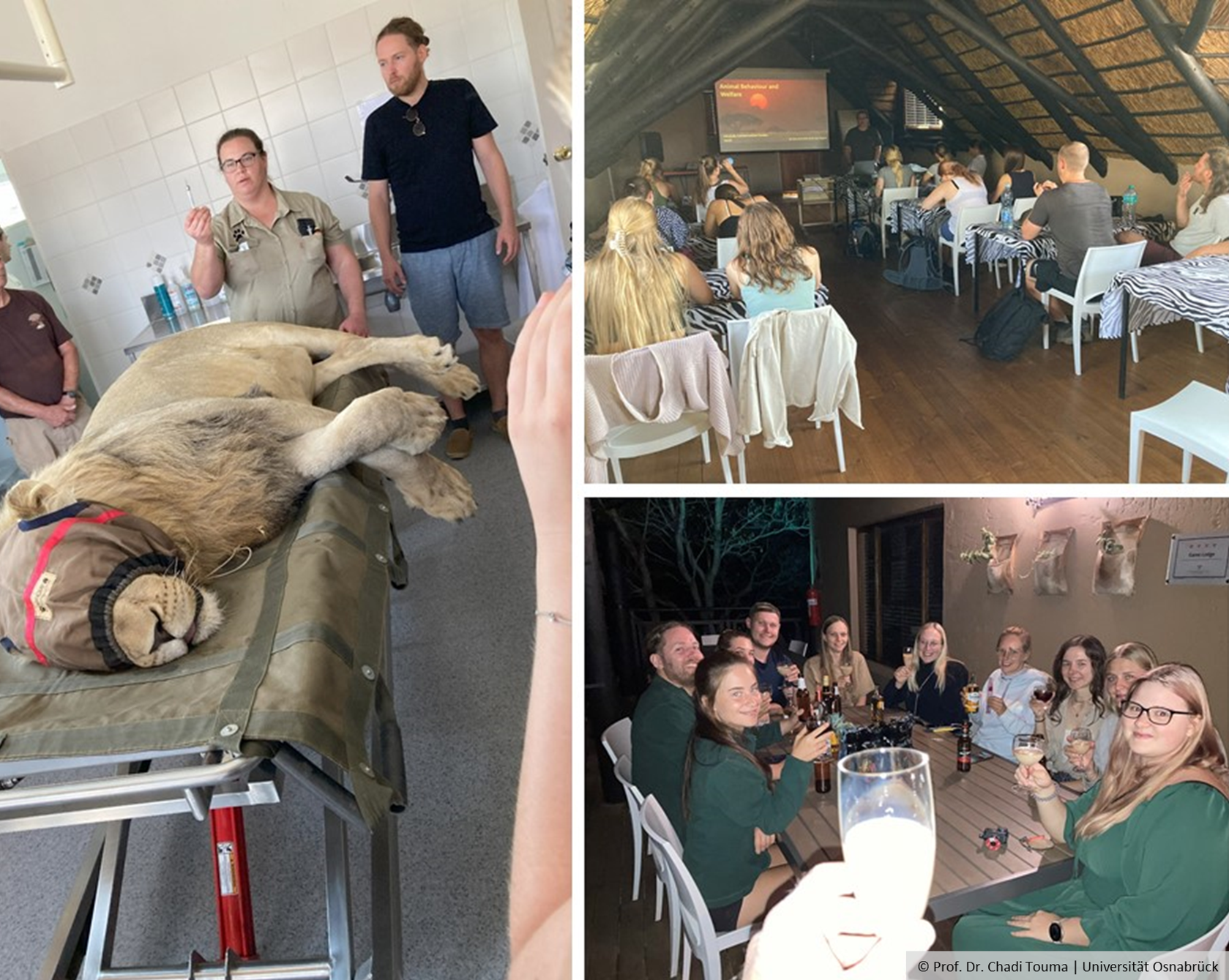Main content
Top content

29.01.2024
From the lecture hall to the savannah: Master's students on an excursion in South Africa
In the summer semester of 2023, twelve master's students from Osnabrück Biology travelled to South Africa as part of the excursion module in Behavioural Biology. Led by Prof. Dr. Chadi Touma, the group spent two weeks exploring the "Mammal Research Institute" at the University of Pretoria, the "Mogalakwena Research Centre," the "Pilanesberg National Park," and the "Ukutula Conservation Centre".
After a gap due to COVID-19, this was the second time the excursion took place. The following report from one participant provides insights into the experiences of the group:
"After weeks of preparation through lectures, seminar presentations, vaccinations and equipped with sufficient mosquito spray, our journey to South Africa finally started on September 10th. Following an eleven-hour overnight flight, we arrived at Johannesburg Airport full of excitement but also a bit tired. From there, we headed directly to Pretoria, where we spent two days exploring the largest university in the country. Through guided tours, presentations, and personal conversations with local lecturers and students, we gained insights into the various research projects and activities of the "Mammal Research Institute" (MRI) and its branches.
From Pretoria, we continued north in university-owned minibuses towards Mogalakwena, leaving the city behind and entering the wilderness. Enthusiastically, we spotted giraffes, ostriches, zebras, monkeys, and antelopes along the roads, which were often filled with potholes and sometimes consisted only of sand. During the next three days at the "Mogalakwena Research Centre" (MRC), we learned not only theoretically but also practically through various field activities about mammals, birds, and the vegetation of Southern Africa. Activities included identifying animal species, correctly attributing tracks and analysing faecal samples. We also experienced the intensity of the African sun while walking through the bush all day, despite the cool mornings. Additionally, we captured small mammals like the desert pygmy mouse in live traps, set up camera traps, and searched for crocodiles, giraffes, and vervet monkeys. These animals tend to disappear suddenly when you want to observe their behaviour. By sampling from the Mogalakwena River, we assessed the ecological condition and water quality of the river based on the contained insects, larvae, worms, and mussels.
An evening highlight was the "Scorpion Walk," where we used UV flashlights to spot scorpions emitting a bright green glow due to their bioluminescence. The “Bush Dinner", a dinner prepared for us in the middle of the bush, accompanied by South African singing and drumming, and followed by stargazing, was also a special experience. On the last night at the Mogalakwena River Lodge, we enjoyed a funny pub quiz and a lively farewell party with local students and MRC staff.

In Mogalakwena, we had the opportunity to participate in a bush dinner, track scorpions, determine the water quality of the local river, and observe various wild animals.
After another long day in the two minibuses on bumpy roads with a quick stop at the supermarket, we arrived after dark at the Kingdom Resort, our accommodation for the next three nights near Pilanesberg National Park.These nights were short, as we explored Pilanesberg National Park from sunrise to sunset on the following two days, with our minibuses transformed into safari vehicles. Through binoculars or suddenly right in front of the car, we observed not only a variety of animals (we counted 43 Southern white rhinoceroses on the first day!) but also witnessed how a part of the park can quickly go up in flames due to human negligence – destroying large areas of wildlife habitat. However, bushfires are not entirely uncommon for South African vegetation and nature should hopefully recover quickly after the next rain, providing good habitats for the animals once again.

During our two days in Pilanesberg National Park, we could not only spot numerous animals from our vehicles but were also repeatedly surprised by its landscape or traces of past bushfires.
As the last stop of our excursion, we spent three days at the "Ukutula Conservation Center" (UCC). Here, large cats like cheetahs and lions are kept and partially hand-raised to offer visitors unique experiences. The animals are also involved in research projects to ensure conservation and species preservation. Daily lectures from the UCC veterinarian provided us with a deeper insight into topics such as nature and species conservation in South Africa, animal care and welfare, wildlife capture, and the issue of poaching. We also participated in the training of cheetahs for non-invasive sample collection, learned about the anaesthesia of wild animals through practical experience and demonstrations by the veterinarian, walked with lions through the bush, and got up close during the examination and semen sample collection of an anesthetized lion. Although it was a special and impressive experience to be so close to the animals, we ultimately agreed that observing wildlife in their natural habitat is clearly more beautiful. The discussion about whether wildlife conservation and preservation can be achieved without captive counterparts, the role of animal welfare or if such facilities focus more on tourism, remains a widely debated topic – not only among us participants of the excursion.

Thanks to the UCC veterinarian, we had the opportunity to participate in the examination of an anesthetized lion and also learned a lot through her insightful lectures. In the evening, while sitting together, we reviewed the day.
On the day of our departure from South Africa, we returned to Pretoria for a brief break, consumed the last remnants of road trip food, admired sculptures made of soapstone by a local artist and, of course, returned the now very dusty cars marked by potholes, speed bumps and thorn bushes. After another 11 hours of overnight flight and a train ride back to Osnabrück, we were all relieved to see our beds.
Grateful for the time we spent together in South Africa, we look back on two very intense and educational weeks. The excursion provided us with the extraordinary opportunity to not only apply behavioural and physiological methods of field research but also gain insights into nature and species conservation as well as the culture of a distant land. As a group, we could experience first-hand current issues and their solutions, engaging in scientific discussions."







